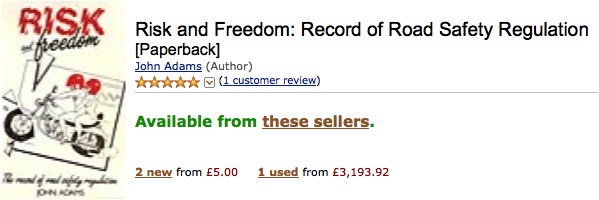From time to time I check on Amazon to see if anyone is buying my 1985 thriller Risk and Freedom – not many.
But views about its value vary widely. The act of reading it, and transforming it into a “used” book, apparently increases its value enormously – I would like to think so..
1 Comment
Risk and Freedom is a book of historic significance. Published in 1985 and out of print for many years it continues to have a profound influence on road safety policy. It provides the first coherent application of the concept of “risk compensation” to the management of risk on the road. Risk compensation is a term coined by Canadian psychologist Gerald Wilde in the 1970s to describe the behavioural adjustments of people to perceived changes in safety or danger. In Risk and Freedom Adams applies the idea to a wide variety of road safety measures – seat belts, helmets, speed limits, alcohol limits, crumple zones and other crash protection measures, improved brakes and tires, and accident blackspot treatments, to name the main ones.
The idea that risk compensation could explain the failure of such measures to achieve their promised benefits was, at the time, unanimously dismissed out of hand by highway engineers, vehicle designers, and regulators. Today it is widely accepted as mere common sense, and serves as the basis for the new, and increasingly popular, shared space schemes. The most obvious explanation for the success of these schemes is Adams’ argument that road users are not obedient automatons, but alert and responsive participants in what Adams calls in his last book, Risk, “the dance of the risk thermostats”. Also, unlike most books on this subject it is well-written and entertaining.

